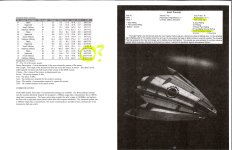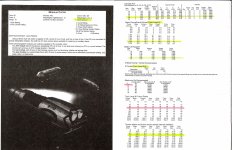They are the numbers that appear in the core rule book for the light fighter. The SSDS and QSDS are for building ships 100t and larger. I think there may be a missing smallcraft design sequence somewhere out there.
I see your point. But, for what it's worth, I have tried to use the "T4 SSDS Rules Revised" that is included on the CD ROM from FFE to experiment with building small craft. I understand it's certainly possible that I'm the only one who's looked at these rules in the last decade or so. But since you suggested they are only used for building ships 100 Tons or larger, I thought I would share the results of what I have found.
Frankly, the answers caught me somewhat off-guard.
First, I have attached below the statistics of the 50 Ton Modular Cutter as published in
T4 Starships. As you can see, it is clearly shown to be a TL-9 spacecraft. (Which, I think, is the same as LBB Book 2
Starships.) Frankly, to give the authors credit, the SSDS rules in
T4 really goes into quite a bit of detail about the differences in Tech Level.
Obviously I have also attached below some of the relevant sections of the SSDS rules. And they show that a 50 Ton, cylindrical hull is available at TL-9. But what isn't available is the Grav Thruster Plates. These are only available at Tech Levels 11+. However, Basic ContraGravity Drives are available at LT-9. However, the SSDS rules state:
"ContraGravity drives are not real maneuver drives, and aren’t useful outside of a gravity well. Their primary use is gravity vehicles. They are included here so that ships below tech level 11 (thruster plates) can hover and maneuver in an atmosphere. By 10 diameters out from a planet, the ContraGravity drive is virtually worthless, only producing 1% of the thrust it would on the surface. Note that the accelerations listed below can only be achieved in a 1G gravity well. Ships that use ContraGravity still need another form of maneuver drive to get out to jump distance. Normally, only enough CG is installed to counter the mass of the ship (use 10x displacement tons as a rule of thumb)."
So, granted, while using ContraGravity drives won''t fly you to Jupiter, they can get you to orbit.
Now here's where we run into a bit of a contradiction. The statistics of the 50 Ton Modular Cutter show that it has a 4G acceleration, but the paragraph above says to use 10x the displacement tons as a rule of thumb, which is normally a 1G acceleration. However, as an experiment, I gave the Modular Cutter design a 4G acceleration, like its statistics suggest. (Which would be 4G x 10 x 50 Tons = 2000 tonnes of thrust.) And as you can see on the chart, this is possible, taking 66.7 cubic meters, or 4.74 Tons, of volume, and requiring 40MW of power.
Basic Life Support is easily accounted for in a 50 Ton hull, but Artificial Gravity / Internal Compensators at TL-9 are not. Instead they must use G-Tanks, which (I assume) are tanks filled with a fluid to alleviate someone from feeling the force of acceleration by keeping them submerged and neutrally buoyant.
This is certainly something I did not see coming. In fact, in the charts below, I have highlighted in pink that Artificial Gravity is only available at TL-10 and above.
The other thing that surprised me is while Fusion Plants are available at TL-9, they're HUGE! You only need 50MW or so to make the 50 Ton Modular Cutter fly. But the smallest Fusion Plants that are available at TL-9 are 2500MW, are are 1250 cubic meters, or 89.2 Tons in volume. That's larger than the 50 Ton hull. It will never fit.
But there are
Fission plants available, and at 50MW takes up 50.0 cubic meters, or 3.57 Tons, which can be made to work.
The whole point to this discussion, is that despite the omission we discussed earlier, you can use the SSDS rules to design small craft. But the results are not necessarily what you would expect. Like most people who play Traveller, I did not imagine the 50 Ton Modular Cutter in
T4 would be powered by Plutonium, and wold require characters to climb into a fish tank in order to get to orbit.
It seems the designers of the game were caught off-guard by their own rules. Which, frankly, is neither a high crime nor misdemeanor. But it is something that makes you say "hmmm..."






